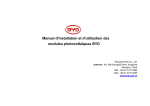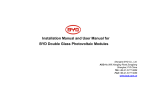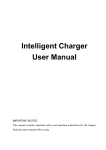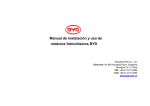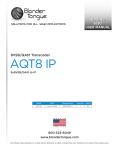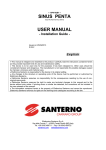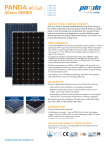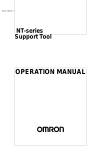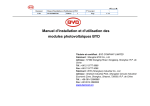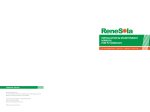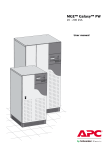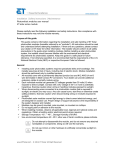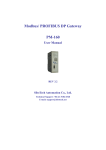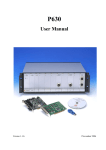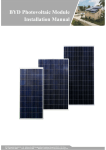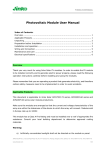Download IEC Installation Manual and User Manual for BYD
Transcript
BYD COMPANY LIMITED Rev. Aug. 24th 2012 IEC Installation Manual and User Manual for BYD Photovoltaic Module BYD(Shanghai) Industrial Co.Ltd ADD:No.999 Xiangjing Road,Songjiang Shanghai, 201611, P.R.China TEL:+86-21-5777 8888 FAX:+86-21-5777 5086 www.byd.com.cn BYD COMPANY LIMITED Rev. Aug. 24th 2012 CONTENT Foreword .................................................................................................................................................................................................................................................... 3 1. Product identification .......................................................................................................................................................................................................................... 3 1.1 Label .............................................................................................................................................................................................................................................................. 3 1.2 Barcode ......................................................................................................................................................................................................................................................... 3 2. Transportation and storage manual ................................................................................................................................................................................................. 4 3. Installation ............................................................................................................................................................................................................................................. 4 3.1 Warning ......................................................................................................................................................................................................................................................... 4 3.2 Mechanical installation ............................................................................................................................................................................................................................... 5 3.2.1 Mounting system ..................................................................................................................................................................................................................................... 5 3.2.2 Clamping .................................................................................................................................................................................................................................................. 6 3.3 Electric installation....................................................................................................................................................................................................................................... 8 3.3.1 Grounding ................................................................................................................................................................................................................................................ 8 3.3.2 General Installation ................................................................................................................................................................................................................................. 9 4. Maintenance and Care ....................................................................................................................................................................................................................... 10 4.1General ........................................................................................................................................................................................................................................................ 10 4.2 Module Cleaning ........................................................................................................................................................................................................................................ 10 5.Claim ................................................................................................................................................................................................................................................... 11 www.byd.com.cn BYD COMPANY LIMITED Rev. Aug. 24th 2012 1.2 Barcode Foreword Each module has only one bar code as follow: This manual includes the transportation, installation and maintenance of PV modules (hereafter referred to as “module”). Please read this manual carefully before installing and using the modules. Please get in touch with provider if you have any questions. This manual is applied to all the standard modules of BYD Company Limited. Keep this guide in a safe place for future reference (care and maintenance) and in case of sale or disposal of the modules. NOTE: All the items in this manual also suit our 3 bus-bar polycrystalline cell PV modules as well as monocrystalline cell modules, and the pictures in the manual, which are 2 bus-bar cell PV modules are just used for examples. 1. Product identification 1.1 Label The label describes the product type, rated power, rated current, rated voltage, open circuit voltage, short circuit current, weight, dimensions etc.; Typical label-A Typical label-B SH 120220 P630 AS68- 001 SH 120820 P630 AS68C001 SH——Manufacturer location, Shanghai; 120220——Date(YYMMDD); P——P for Poly –Si, M for Mono-Si, L for Mono-Like Si; 6——6 for the cell dimension of 156*156,5 for the cell dimension of 125*125mm; 30——the voltage of the modules; AS68- or AS68C — — Engineering Code ,for different shifts, materials etc; 001——Number of product components,3 digit sequence 0 to 999 for sequential production starting on each new day of production at 001. BYD COMPANY LIMITED 2. Transportation and storage manual Please observe the follow criterion after packing. (1) Don’t lean ≥15° when transit packing boxes. (2)Box up according to the sign of packing box. (3)Be careful of transit, and don’t strike violence. (4)The packing boxes should be protected from rain. (5)Transportation condition should satisfy the packing boxes’ requirement and modules’ requirement of environment. 3. Installation 3.1 Warning (1) Do not use mirrors or other magnifiers to artificially concentrate sunlight on the modules. (2) Do not touch live terminals with bare hands. Use insulated tools for electrical. (3) Although modules are quite durable, the glass can be broken (and the module will no longer work properly) if it is dropped or hit by tools or other objects. (4) Under normal conditions, a photovoltaic module is likely to experience conditions that produce more current and/or voltage than reported at standard test conditions. Accordingly, the value of Isc and Voc marked on this module should be multiplied by of 1.25 when Rev. Aug. 24th 2012 determining component voltage ratings, conductor current ratings, fuse sizes, and size of controls connected to the PV output. (5) The installation work of the PV array can only be done under the protection of sun-sheltering covers or sunshades and only qualified person can install or perform maintenance work on this module. (6) Systems should be installed by qualified personnel only and at least two persons. The system involves electricity, and can be dangerous if the personnel are not familiar with the appropriate safety procedures. (7) Follow the battery manufacture’s recommendations if batteries are used with modules. Please observe the native rule and law when install modules. You must obtain the architecture license. (8) Please unpack carefully. (9) Optical check before installation, to make sure there is no bug in the packing and junction box as well as the surface of module. (10)The users should design and build metallic bracket for installing and bearing the weight of the PV modules. The brackets are specially designed for users’ installation places such as the open land or on the roof of houses. (11)In most applications, PV modules should be installed in a location where they will receive maximum sunlight throughout the year. In the Northern Hemisphere, the modules should typically face south, and in the Southern Hemisphere, the modules should typically face north. When choosing a site, avoid trees, buildings or obstructions, which could cast shadows on the solar. When choosing clamping or insertion system, according to PV’s specification choosing appropriate www.byd.com.cn BYD COMPANY LIMITED bracket, bracket should occur corrosion. (12) Put the modules on the frame and put on the screws and then combine them firmly after put on all the washers. All the screw caps should be finished on the frame together firmly. The module frame is made of anodized aluminum, and therefore corrosion can occur if the module is subject to a salt-water environment with contact to a rack of another type of metal. (Electrolysis Corrosion) if required. Stainless steel washers can be placed between the solar module frame and support structure to prevent this corrosion. (13)Don't envelop the drain holes with other components when install modules. Junction box should at the top of the module. (14)Don’t grasp the junction box or cable when install modules. (15) For roof application, the PV system must be mounted, over fire resistant roof covering rated for the application. Do not use modules near equipment or in places where flammable gases may be generated. (16)The obliquity of PV array should follow the fire test request in IEC 61730-2 when modules are installed in rooftop. (17)The ambient temperature range of install location is -40~+85°C. Rev. Aug. 24th 2012 CAUTION: Please unpack in appropriate environment, and use special tool. The modules should be water proof and damp proof. NOTE: BYD does not limit the materials of the installation if the materials can be used outdoor for 25 years. 3.2 Mechanical installation 3.2.1 Mounting system Use mounting holes to fix up as the follow figure ,and users must tighten screws with the fastening torque. For a 5400Pa load, use eight mounting holes. Mounting holes introduction: DANGER: One single module may generate more than 30V DC when exposed to direct sunlight. If modules are in series, voltage is equal to the sum of every module’s voltage. If modules are in parallel, current is equal to the sum of every module’s current. If many modules have been installed in series or in parallel, please don’t touch by hand without any insulated equipment. www.byd.com.cn BYD COMPANY LIMITED Model measure P6-18/ P6-24/ P6-27/ P6-30/ P6-36/ M6-18 M6-24 M6-27 M6-30 M6-36 L 1482 1325 1482 1640 1956 W 676 992 992 992 992 T 50/40 50/40 50/40 50/40 50/40 A 626 942 942 942 942 B 802 476 500 860 800 C / 1076 1100 1360 1300 Rev. Aug. 24th 2012 clamps must have enough intensity to fix up modules (recommending using stainless steel), and their structure couldn’t shelter the cells. Module installed with clamps on a long frame, “B’” is the clamping range: The detail of installation: For a 5400Pa load, use four clamps on a long frame model P6-18/ P6-24/ P6-27/ P6-30/ P6-36/ M6-18 M6-24 M6-27 M6-30 M6-36 A 120 110 120 140 328 B 250 250 250 300 250 measure For a 5400Pa load NOTE: A is the distance form module edge to clamping range, 3.2.2 Clamping B is the clamping range. Modules could use the clamps as the follow picture, the www.byd.com.cn BYD COMPANY LIMITED Installation: Rev. Aug. 24th 2012 Installation: CAUTION: This method just can be used less than 2400Pa We advise users using the installation as the two pictures above. Installation clamping methods on a short frame as below: pressure and BYD does not take on the responsibility if the module is broken with more than 2400Pa pressure. (3) Insertion system Modules could use insertion system as the follow picture to install, and the insertion system must have enough intensity to fix up modules, such as stainless steel and other appropriate metal to support PV module. When insertion system install on a long frame, the insertion system should not shelter the grounding holes. For a 2400Pa load only, use four clamps on a short frame For a 5400Pa load, use an insertion system on a long frame www.byd.com.cn BYD COMPANY LIMITED We advise users using the installation method as the picture above but not forcibly. This method can make modules have a good intensity. Rev. Aug. 24th 2012 (2) For grounding and bonding requirements, please refer to regional and national safety and electricity standards. If grounding is required, use a recommended connector type, or an equivalent, for the grounding wire. The grounding wire must be properly fastened to the module frame to assure adequate electrical connection. (3) The grounding has many methods . Only to assures safety is OK, we recommend one method as below: For a 2400Pa load only, use an insertion system on a short frame CAUTION: This method just can be used less than 2400Pa pressure and BYD does not take on the responsibility if the module is broken with more than 2400Pa pressure. 3.3 Electric installation 3.3.1 Grounding (1) Grounding: All module frames should be grounded for safety. It is not recommended to use modules with different configurations (grounding, wiring) in the same system. The combination of the material of frame and the material of grounding would not result in galvanic corrosion. (4) All module frames should be grounded for safety. The grounding connections between modules must be approved by a qualified electrician, the grounding itself must be made by a qualified electrician. The ground wire should be at least the same size as the electrical conductors. (5)In order to avoid the damage caused by PID, BYD suggests that the negative of inverter should be grounded. (6) The grounding system must be installed well. www.byd.com.cn BYD COMPANY LIMITED CAUTION: BYD provide the mounting holes, drain holes and grounding holes. These holes have passed the safety testing. Installers can’t drill and block drain holes random. Rev. Aug. 24th 2012 on system design, the type of inverter used and environmental conditions. According to the system voltage (1000V) of IEC standard, we recommend the maximum number of modules in series as below: 3.3.2 General Installation Type (1)When the system, the modules connect in series or parallel generally, we recommend simple serial -connection and parallelconnection with the modes as below. Serial –connection of modules: The maximum number of modules in series BYD ***P6-18/M6-18 No more than forty BYD ***P6-24/M6-24 No more than thirty-five BYD ***P6-27/M6-27 No more than thirty BYD ***P6-30/M6-30 No more than twenty-five BYD ***P6-36/M6-36 No more than twenty (5)There is no limitation on the number of modules that can be connected in parallel, the number of modules is determined by system design parameters such as current or power output. Every PV array in parallel should install protection circuit. (6) Please refer to local regulations to determine the system wires size, type and temperature. To prevent the cables and the connectors from overheating, the cross section of the cables and the capacity of the connectors must be selected to suit the maximum system short circuit current (The recommended cable cross section is 4mm2 for a single module and if rated current of a connector is higher than 10A). Parallel- connection of modules (2) The bypass diode have a Rated Average Forward Current 10A at least, and a Rated Repetitive Peak Reverse Voltage 40V at least. (3) The maximum number of series connected modules depends www.byd.com.cn NOTE: Please note that the upper limit temperature of cable is 90°C, and the upper limit temperature of the connector is 100°C. BYD COMPANY LIMITED 4. Maintenance and Care Rev. Aug. 24th 2012 CAUTION: If the system goes wrong, please let the professional engineers deal with it. Others should not disassemble the system optionally. 4.1General The inspection should confirm the following: (1) Check the module’s setting of machine on time. Check the support equipment (fastness, erosion, bolts and nuts, especially the place where the wind or shake is hard. Ensure the fixing is fast. If not fast, screw them down.) If the condition permits, the metal fittings that fasten or support the modules should be protected from the eroded, such as the bolts and nuts. A first check after 12 months and an additional check after 120 months should be made. (2)Check the module’s electric line (connection to the equipment and earth) for a settled time. Check the grounded resistance satisfying the designation request. If the connection is not fast, jointing it. After the thunderstorm or before, check the junction box and other protectors for the thunder. If invalidation, replace it according to the request. (3)Check the lead connector for the leakage current and deal with it. Be care for the rainy or snowy weather which affects the leakage current. When checking the lead, People must take the insulated sets (such as tools and gloves). Don’t touch the uncovered lead or the connectors with uncovered hands. Check the connections of each part to ensure them fast, if not, connect them. Wipe the dust up from the equipment regularly to keep it clean. (4) If the module needs repaired, covered with fabric or other material. Or it may produce high voltage under the sun. 4.2 Module Cleaning Over dirt and dust can accumulate on the glass surface of the module, reducing its power output.BYD recommends periodic cleaning of PV modules to ensure maximum power output especially when the modules do not have the expected power output. Check the glass to ensure the surface is good before cleaning. If it is broken, please do not clean and inform to the purchaser and maintenance. Do not wear the watch or jewellery when cleaning. Use the soft fabric clean out the dust. If the dust is hard to wipe out, use the water to clean. Then use the clean fabric wiping up the water carefully. Do not use hard tools or mordant solution wiping the module for avoiding leaving scrape so as to affect the light transmission efficiency. The power attenuation caused by the scrape is beyond our guarantee range. Do not wipe on the day, and you had better to clean on the night or morning without strong sunshine. Do not use the cold water to clean the module so as to avoiding broking the glass. www.byd.com.cn BYD COMPANY LIMITED Rev. Aug. 24th 2012 5.Claim NOTE: A note provides information about installation, As the adherence to this manual and the conditions or methods of installation, operation, use and maintenance of photovoltaic (PV) products are beyond BYD’s control, BYD does not accept responsibility and expressly disclaims liability for any loss, damage, or expense arising out of or in any way connected with such installation, operation, use or maintenance. The information in this manual is based on BYD’s knowledge and experience and is believed to be reliable. The manual provides reference, and consumer could choose appropriate installation according to place and environment. BYD reserves the right to change the manual, the PV produce, the specifications, or product information sheets without prior notice. www.byd.com.cn operation, or maintenance of the module that is important to know, but it is not necessarily hazardous. CAUTION: A caution message indicate a potential threat to minor injury, or alerts against behavior that can lead to property damage. DANGER: A danger message indicates a hazard in the immediate area which, if not avoided, can result in death or serious injury.












